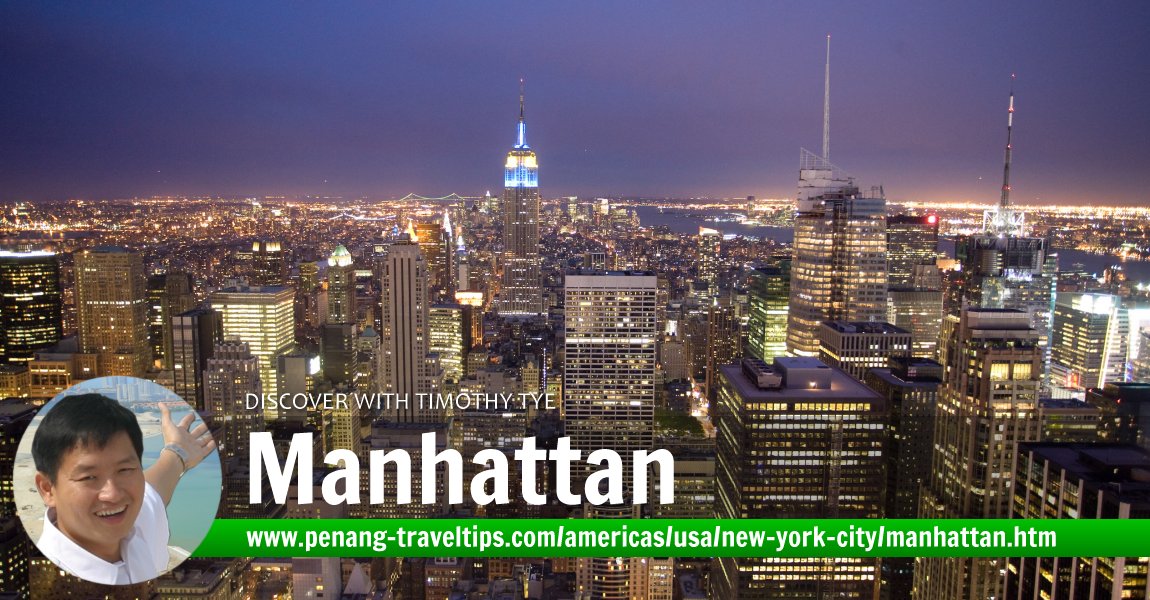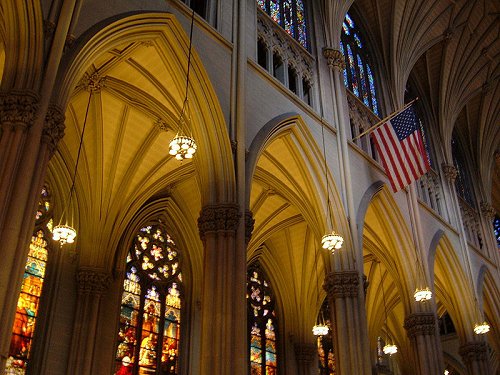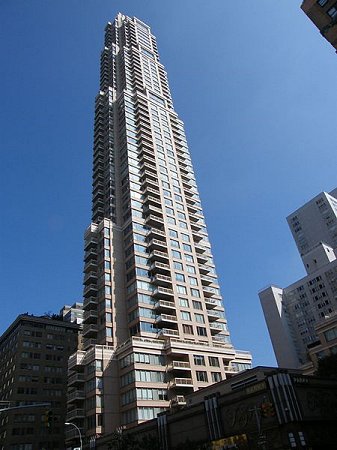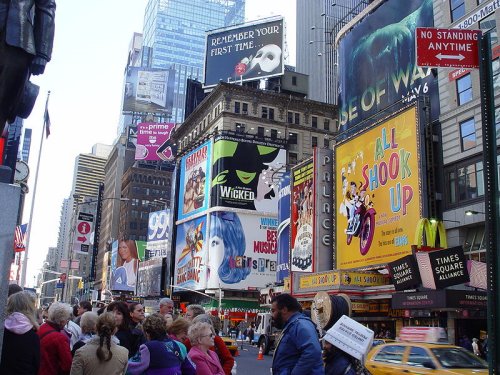 Manhattan, New York City
Manhattan, New York CitySource: https://commons.wikimedia.org/wiki/File:The_Big_Apple.jpg
Author: Kenny Louie

Manhattan is the oldest and most densely populated borough of New York City. Covering 33.77 sq mi (87.5 sq km), of which the land area is only 22.96 sq mi (59.5 sq km), it includes not only the island of Manhattan, but also a number of small adjacent islands such as Roosevelt Island, Randall's Island, Wards Island, Governors Island, Liberty Island, a section of Ellis Island, Mill Rock and U Thant Island. Marble Hill, which is on the mainland adjacent to the Bronx is also part of the borough of Manhattan.
The boundary of the borough of Manhattan is identical to that of New York County, the original county in which New York City was located, within New York State. In fact, New York City started at the southern tip of Manhattan, where Battery Park is located, and over time has expanded to cover not only Manhattan Island, but the surrounding boroughs as well.
The borough of Manhattan has a population of 1.64 million people (2011 estimate) crammed into 22.96 sq mi. While its population is the third highest among the five boroughs of New York City, it is by far the most densely populated, with 71,201 people for every square mile. It also has one of the highest annual per capita incomes of any county in the United States, exceeding $100,000.
Map of the different portions of Manhattan
 Police Department Building, NoLIta, Manhattan
Police Department Building, NoLIta, ManhattanSource: https://commons.wikimedia.org/wiki/File:Police_Building_dome_and_pediment.jpg
Author: Beyond My Ken

 Interior of St Patrick's Cathedral, Manhattan
Interior of St Patrick's Cathedral, ManhattanSource: https://commons.wikimedia.org/wiki/File:St.Patrick%27s_Cathedral_NYC1.jpg
Author: hereiam_now

Manhattan is a major commercial, financial, and cultural center of both the United States and the world. Most major radio, television, and telecommunications companies in the United States are based here, as well as many news, magazine, book, and other media publishers.
Manhattan has many famous landmarks, tourist attractions, museums, and universities. It is also home to the headquarters of the United Nations. Manhattan has the largest central business district in the United States, is the site of both the New York Stock Exchange and NASDAQ, and is the home to the largest number of corporate headquarters in the nation. It is indisputably the center of New York City and the New York metropolitan region, holding the seat of city government, and the largest fraction of employment, business, and recreational activities.
 Trump Palace Condominiums, Manhattan
Trump Palace Condominiums, ManhattanSource: https://commons.wikimedia.org/wiki/File:Trump-palace1.jpg
Author: Americasroof

Manhattan can be divided into three sections: Downtown, Midtown and Uptown. It is bordered to the west by the Hudson River, to the east by the East River, and to the south by New York Harbor. Separating the island of Manhattan with mainland United States, where the borough of The Bronx is located, is the Harlem River.
Apart from the older streets in Downtown Manhattan, the rest of the island is laid out in a grid designed by the Commissioners' Plan of 1811. It divides Manhattan with 12 parallel avenues running roughly north-south down the island. These are 100 feet (30 m) wide and 600 ft apart. They are intersected by regular streets which are 60 ft (18 m) wide and 15 crosstown streets which are 100 ft (30 m) wide. The plan is interrupted in some areas such as Central Park. Also, the oldest street in Manhattan, Broadway, cuts diagonally across the grid, creating major intersections.
Manhattan experiences a humid subtropical climate. Summers are warm and humid, with average temperatures reaching 90°F (32°C) regularly. On the other hand average winter temperature, in January, is around 26.2°F (-3.2°C). Rainfall is quite evenly spread out with snow in January and February.
 Theater District, Manhattan
Theater District, ManhattanSource: https://commons.wikimedia.org/wiki/File:Broadway-Plakate.jpg
Author: Martin Dürrschnabel

Exploring Manhattan
The most economical way to explore Manhattan is to take the subway, if not on foot. Alternatively there's plenty of taxis to take you around should you get lost.Geographical Delineation of Manhattan
Neighborhoods in Manhattan
The following is an alphabetical arrangement of the neighborhoods of Manhattan.- Alphabet City
- Astor Row
- Battery Park City
- Bowery
- Carnegie Hill
- Chelsea
- Chinatown
- Civic Center
- Columbus Circle
- Cooperative Village
- Diamond District
- East Harlem
- East Village
- Financial District
- Flatiron District
- Fort George
- Garment District
- Gramercy Park
- Greenwich Village
- Hamilton Heights
- Harlem
- Hell's Kitchen
- Herald Square
- Hudson Heights
- Hudson Yards
- Inwood
- Kips Bay
- Koreatown
- Le Petit Senegal
- Lenox Hill
- Lincoln Square
- Little Italy
- Lower East Side
- Madison Square
- Manhattan Valley
- Manhattanville
- Marble Hill
- Marcus Garvey Park
- Meatpacking District
- Midtown
- Morningside Heights
- Murray Hill
- NoHo
- NoLIta
- NoMad
- Peter Cooper Village
- Rose Hill
- SoHo
- South Street Seaport
- Strivers' Row
- Stuyvesant Square
- Stuyvesant Town
- Sugar Hill
- Sutton Place
- Tenderloin
- Theater District
- Times Square
- TriBeCa
- Tudor City
- Turtle Bay
- Two Bridges
- Union Square
- Upper East Side
- Upper Manhattan
- Upper West Side
- ViVa
- Washington Heights
- Waterside Plaza
- West Village
- Yorkville
Islands of Manhattan Borough
- Ellis Island
- Governors Island
- Liberty Island
- Randall's Island
- Roosevelt Island
- Wards Island
 Latest updates on Penang Travel Tips
Latest updates on Penang Travel Tips

Copyright © 2003-2025 Timothy Tye. All Rights Reserved.

 Go Back
Go Back